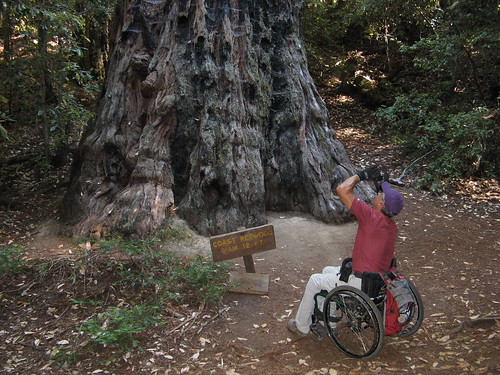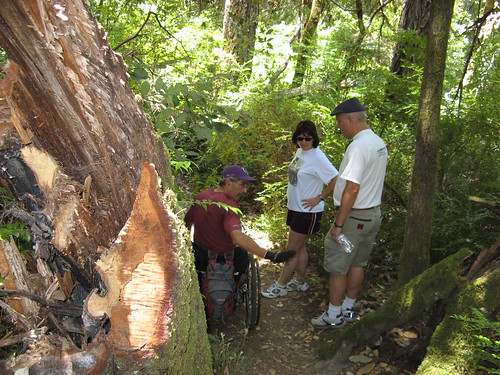“This looks pretty steep through here, ” I say. “You sure you want to try it?”
“You can’t let six feet of trail defeat you,” Bob says. What happens next is an unforgettable hiking-with-Bob moment.
Bob has gotten his chair most of the way up the steep spot but has to execute a turn between a sapling on his right and the hillside on his left. It’s a tricky maneuver that obliges him to grab the sapling with one hand while trying to nudge the chair through with the other.
Gravity intervenes and the chair slips out from underneath him and starts rolling back down the hill. Bob grabs the tree with both hands, holding himself at an angle that keeps as much weight off his legs as possible, while I dash past and grab the chair, which seems to weigh a ton when I lug it back up to a flat spot past the sapling, where Bob can contort himself back into the seat and we can hike on.
Momentary emergencies like this are old hat for Bob, better known in hiking circles as 4WheelBob. You might wonder: why didn’t I do something to help to avoid this from happening in the first place? Well, until something like this happens you figure Bob doesn’t need help. Like so many wheelchair athletes, experience tells him how to choose his battles; you help out when the need’s obvious but otherwise the Hiker’s Code applies: Bob hikes his own hike.
Later we were hiking through a creekbed, Bob picking his way through the smooth stones. A passing hiker asks if he needs help. “It’s not as hard as it looks,” Bob says reassuringly. I suspect otherwise.
OK, so this feels a bit weird to be writing about Bob as if he’s not in the room — he’s one of my regular readers so I know he’s seeing all this. But he’s gotten used to people writing about him. Backpacker magazine profiled his quest to summit White Mountain a couple years back. He was portrayed as somewhere between determined and deranged.
For those who don’t know Bob’s story: Diabetes has made his leg bones so brittle they break if he tries to stand up on them. He has some use of his lower extremities; he can operate the pedals on his car, for instance.
Bob grew up in the Bay Area and spent many formative days and nights of his youth camping, hiking, fishing and biking in the Santa Cruz Mountains. He was a competitive athlete all his life till his body said enough of all that.
On Sunday we traveled to Portola Redwoods State Park, back to the hills of Bob’s youth. We hiked for about three hours in the cool shade of that wonderful redwood forest. First we headed up the Old Tree Trail, where I started getting a lesson in Bob’s technique. On easy grades he pushes forward, but on steep grades he reverses and pulls himself up.
Bob takes a picture at the Old Tree.
Bob chats with passing hikers on the Iverson Trail, not far from the site of the runaway-chair incident. By this point we’d already gone down to the Pescadero Creek, taken a lunch break and headed back to the park HQ. About three miles in three hours, I’m guessing.
People tend to become almost inappropriately amazed at Bob’s ability to get himself into parts of the wilderness where the disabled rarely travel. People with disabilities do this kind of stuff all the time, just not out in the woods.
I’m sure anybody who’s hiked with Bob can back me up on this: he simply adores the outdoors and cannot imagine doing anything else. It’s certainly not easy hiking on wheels, but in Bob’s case it’s not amazing. It’s inevitable.



Nice hike! Wish I had been part of the epic journey!
I’ve just stumbled onto your posts, bloody brillant stuff! You really know how to remove the “dis” and turn it to ability. I would not mind getting some further feedback from you at a later stage, in regards to your travels bloody interesting and inspiring stuff.
Bob, did you ever make it up White?
Bob’s planning on trying it again in August.
Fedak, I’ll be back up to the Whites Aug 17. I have 10 days to acclimatize, and trundle forth – about twice as long as I have taken in the past. I intend to take my time this time, as the trail IS achievable. My wife isn’t going to let me home unless I get it done, either…and I’ve got Kili in my sights next year if I can get this one under my belt.
Portola was a fun hike, and a real test, escape attempts by nervous chairs notwithstanding. We did manage to coin a new measurement, though – “Bob Miles”…it may only have been 1.5 miles or so, but it sure felt like 6 at my speed! And I got a peek at what I’ve been missing by staying inland so much – between the adjoining state parks, the Mid – Pen Open Space District has an unbelieveable system of trails and land preserved. I’ll be over there exploring much more frequently, for sure.